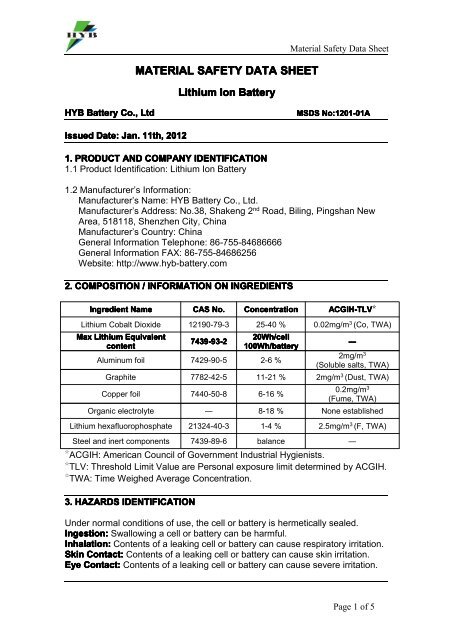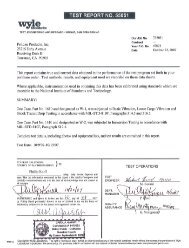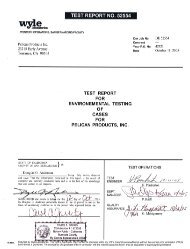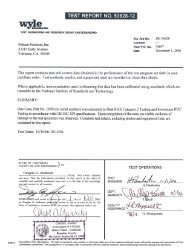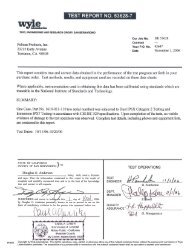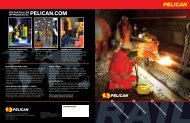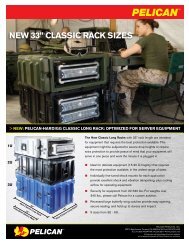9420 MSDS.pdf - Pelican
9420 MSDS.pdf - Pelican
9420 MSDS.pdf - Pelican
Create successful ePaper yourself
Turn your PDF publications into a flip-book with our unique Google optimized e-Paper software.
MATERIAL SAFETY DATA SHEET<br />
Lithium Ion Battery<br />
Material Safety Data Sheet<br />
HYB Battery Co., Ltd<br />
<strong>MSDS</strong> No:1201-01A<br />
Issued Date: Jan. 11th, 2012<br />
1. PRODUCT AND COMPANY IDENTIFICATION<br />
1.1 Product Identification: Lithium Ion Battery<br />
1.2 Manufacturer’s Information:<br />
Manufacturer’s Name: HYB Battery Co., Ltd.<br />
Manufacturer’s Address: No.38, Shakeng 2 nd Road, Biling, Pingshan New<br />
Area, 518118, Shenzhen City, China<br />
Manufacturer’s Country: China<br />
General Information Telephone: 86-755-84686666<br />
General Information FAX: 86-755-84686256<br />
Website: http://www.hyb-battery.com<br />
2. COMPOSITION / INFORMATION ON INGREDIENTS<br />
☆<br />
☆<br />
☆<br />
Ingredient Name<br />
CAS No.<br />
Concentration<br />
ACGIH-TLV ☆<br />
Lithium Cobalt Dioxide 12190-79-3 25-40 % 0.02mg/m 3 (Co, TWA)<br />
Max Lithium Equivalent<br />
content<br />
7439-93-2<br />
20Wh/cell<br />
100Wh/battery<br />
Aluminum foil 7429-90-5 2-6 %<br />
―<br />
2mg/m 3<br />
(Soluble salts, TWA)<br />
Graphite 7782-42-5 11-21 % 2mg/m 3 (Dust, TWA)<br />
Copper foil 7440-50-8 6-16 %<br />
0.2mg/m 3<br />
(Fume, TWA)<br />
Organic electrolyte ― 8-18 % None established<br />
Lithium hexafluorophosphate 21324-40-3 1-4 % 2.5mg/m 3 (F, TWA)<br />
Steel and inert components 7439-89-6 balance ―<br />
ACGIH: American Council of Government Industrial Hygienists.<br />
TLV: Threshold Limit Value are Personal exposure limit determined by ACGIH.<br />
TWA: Time Weighed Average Concentration.<br />
3. HAZARDS IDENTIFICATION<br />
Under normal conditions of use, the cell or battery is hermetically sealed.<br />
Ingestion: Swallowing a cell or battery can be harmful.<br />
Inhalation: Contents of a leaking cell or battery can cause respiratory irritation.<br />
Skin Contact: Contents of a leaking cell or battery can cause skin irritation.<br />
Eye Contact: Contents of a leaking cell or battery can cause severe irritation.<br />
Page 1 of 5
Material Safety Data Sheet<br />
4. FIRST-AID MEASURES<br />
Ingestion: Do not induce vomiting or give food or drink. Seek medical attention<br />
immediately.<br />
Inhalation: Provide fresh air and seek medical attention.<br />
Eyes contact: Immediately flush eyes thoroughly with water for at least 15<br />
minutes, lifting upper and lower lids, until no evidence of the chemical remains.<br />
Seek medical attention.<br />
Skin contact: Remove contaminated clothing and thoroughly wash with soap<br />
and plenty of water. If irritation persists, seek medical attention.<br />
5. FIRE-FIGHTING MEASURE<br />
Hazardous Combustion Products: When burned, hazardous products of<br />
combustion including fumes of carbon monoxide, carbon dioxide, and fluorine<br />
can occur.<br />
Extinguishing Media: Water, carbon dioxide, dry chemical, or foam.<br />
Basic Fire Fighting Procedures: Wear NIOSH/MSHA approved positive<br />
pressure self-contained breathing apparatus and protective clothing to prevent<br />
contact with skin and eyes.<br />
Unusual Fire & Explosion Hazards: This material does not represent an<br />
unusual fire or explosion hazard.<br />
Auto-i<br />
-ignition<br />
Temperature: No Data.<br />
Flammability Limits in Air, Lower, % by Volume: 1.4<br />
Flammability Limits in Air, Upper, % by Volume: 11<br />
6. ACCIDENTAL RELEASE MEASURES<br />
.To cleanup leaking cells and batteries:<br />
Ventilation Requirements: Room ventilation may be required in areas where<br />
there are open or leaking cells and batteries.<br />
Respiratory Protection: Avoid exposure to electrolyte fumes from open or<br />
leaking cells and batteries.<br />
Eye protection: Wear safety glasses with side shields if handling an open or<br />
leaking cell or battery.<br />
Gloves: Use neoprene or nature rubber gloves if handling an open or leaking<br />
cell or battery.<br />
Battery materials should be collected in a leak-proof container.<br />
7. HANDLING AND STORAGE<br />
Storage: Do not place the cell or battery near heating equipment, nor expose to<br />
direct sunlight for long periods. Elevated temperatures can result in shortened<br />
battery life and degrade performance.<br />
Store in cool place (temperature: -20-45C, humidity: 45-75%).<br />
Mechanical Containment: If potting or sealing the cell or battery in an airtight<br />
or watertight container is required, consult your HYB Battery Co., Ltd.<br />
Representative for precautionary suggestions. Do not obstruct safety release<br />
vents on cells. Encapsulation of batteries will not allow cell venting and can<br />
cause high pressure rupture.<br />
Handling: Never throw out cells in a fire or expose to high temperatures. Do not<br />
soak cells in water and seawater. Do not expose to strong oxidizers. Do not<br />
Page 2 of 5
Material Safety Data Sheet<br />
give a strong mechanical shock or throw down. Never disassemble, modify or<br />
deform. Do not connect the positive terminal to the negative terminal with<br />
electrically conductive material. Incompatible products: Conductive materials,<br />
water, seawater, strong oxidizers and strong acids Packing material<br />
(recommended, not suitable): Insulative and tearproof materials are<br />
recommended.<br />
The contents of an leaking cell, when exposed to water, may result in a fire<br />
and/or explosion. Crushed or damaged cells and batteries may result in a fire.<br />
8. EXPOSURE CONTROLS / PERSONAL PROTECTION<br />
Engineering controls: Investigate engineering techniques to reduce exposures<br />
use with adequate ventilation and recommended personal protective equipment.<br />
Eye/Face protection: Use good industrial practice to avoid eye contact.<br />
Processing of this product releases vapors or fumes which may cause eye<br />
irritation. Where eye contact may be likely wear chemical goggles and have eye<br />
flushing equipment available<br />
Skin protection: Minimize skin contamination by following good industrial<br />
hygiene practices. Wearing protective gloves is recommended. Wash hands<br />
and contaminated skin thoroughly after handling.<br />
Respiratory protection: Avoid breathing dust and processing vapors. When<br />
adequate ventilation is not available, wear a NIOSH/MSHA respirator approved<br />
for protection against inorganic dusts.<br />
Special clothing: Robber gloves.<br />
9. PHYSICAL and CHEMICAL PROPERTIES<br />
Physical state: Solid<br />
Form: Geometric solid<br />
Color: Metallic color (without outer PVC cover)<br />
Odor: No odor<br />
pH: Not Applicable<br />
Flash point: Not Applicable<br />
Explosion properties: Not Applicable<br />
Density: Not Applicable<br />
Solubility: Not Soluble<br />
10. STABILITY AND REACTIVITY<br />
Hazardous reactions may occur under some specific conditions:<br />
Conditions to avoid: When a battery cell is exposed to an external short-circuit,<br />
crushes, modification, high temperature above 100 degree C, it will be the<br />
cause of heat generation and ignition. Avoid to be exposed to direct sunlight<br />
and high humidity.<br />
Materials to avoid: Conductive materials, water, seawater, strong oxidizers<br />
and strong acids.<br />
Hazardous decomposition products: Acrid or harmful gas is emitted during<br />
fire.<br />
11. TOXICOLOGICAL INFORMATION<br />
Lithium Ion cells and batteries are not hazardous waste. Under normal<br />
Page 3 of 5
Material Safety Data Sheet<br />
conditions of use, lithium Ion or lithium polymer cells and batteries are non-toxic.<br />
_______________________________________________________________<br />
12. ECOLOGICAL INFORMATION<br />
Issues such as ecotoxicity, persistence and bioaccumulation are not applicable<br />
for articles.<br />
13. DISPOSAL CONSIDERATIONS<br />
Waste disposal must be in accordance with the applicable regulations.<br />
Disposal of the lithium ion cells or batteries should be performed by<br />
permitted, professional disposal Page: firms knowledgeable in State or<br />
Local requirements of hazardous waste treatment and hazardous waste<br />
transportation. Incineration should never be performed by battery but users,<br />
eventually by trained professional in authorized facility with proper gas and<br />
fume treatment.<br />
14. TRANSPORT/SHIPPING INFORMATION<br />
In general, the transportation of lithium Ion cells and batteries is regulated as<br />
UN3480 & UN3481 by the International Civil Aviation Organization, International<br />
Air Transport Association, and International Maritime Dangerous Goods Code.<br />
However, for air shipment, the lithium ion or lithium polymer cells and batteries<br />
must comply with section Ⅱ of PI965~PI967 per the 53 th edition of the IATA<br />
Dangerous Goods Regulations.<br />
The cells or batteries for air shipment must comply with Section 2 of PI 965~PI<br />
967 accordingly as “Not Restricted” Cargo:<br />
● For cells, the watt-hour rating should not be more than 20Wh.<br />
For batteries, the watt-hour rating should not be more than 100Wh.<br />
Watt-hour rating must be marked on the outside of the battery case except<br />
those manufactured before 1 January 2009, which may be transported<br />
without this marking until 31 December 2010.<br />
● Each cell or battery is of the type proven to meet the requirements of each<br />
test in the UN Manual of Test and Criteria, Part Ⅲ, subsection 38.3.<br />
● Packing requirements:<br />
General packing requirement: Cells and batteries must be packed in strong<br />
outer packagings that conform to 5.0.2.4, 5.0.2.6.1 and 5.0.12.1.<br />
Additional requirements: 1) Cells and batteries must be packed in inner<br />
packagings that completely enclose the cell or battery. 2) Cells and batteries<br />
must be protected so as to prevent short circuits.3) Each package must be<br />
capable of withstanding a 1.2m drop test in any orientation without damage<br />
to cells or batteries contained therein, shifting of the contents so as to allow<br />
battery to battery contact and release of contents.<br />
● Each package must be labeled with a lithium battery handling label.<br />
● Limitation of weight:<br />
Quantity per package for both Passenger Aircraft and Cargo Aircraft can<br />
only have 10Kg in gross weight.<br />
● Overpacks: Individual packages each complies with the requirements of<br />
part 1 may be placed in an overpack. An over-pack must be marked with the<br />
Page 4 of 5
Material Safety Data Sheet<br />
Word “Overpack” and labeled with the lithium battery label, unless the labels<br />
on the package inside the overpack are visible.<br />
By complying with the requirements specified above, Lithium ion cells and<br />
batteries are not otherwise regulated as Dangerous Goods.<br />
Lithium ion cells or batteries manufactured, packaged and shipped by HYB<br />
Battery Co., Ltd meet the requirements specified above. Any Lithium ion cells or<br />
batteries subsequently repackaged or reshipped are required to meet all of the<br />
requirements specified above.<br />
_______________________________________________________________<br />
15. REGULATORY INFORMATION<br />
Special requirements should be according to the local regulations.<br />
16. OTHER INFORMATION<br />
The data in this Material Safety Data Sheet relates only to the specific material<br />
designate herein.<br />
For more information, please contact:<br />
Cai Yijun<br />
Sales manager<br />
Address: No.38, Shakeng 2 nd Road, Biling, Pingshan New Area, 518118,<br />
Shenzhen City, China<br />
Tel:86-755-84686666-1238<br />
Fax:86-755-84686256<br />
Mobile phone: +86-13509687845<br />
E-mail: cyj@hyb-battery.com<br />
Page 5 of 5


